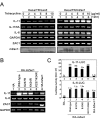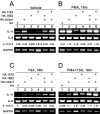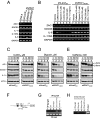Zac1 regulates IL-11 expression in osteoarthritis
- PMID: 30197757
- PMCID: PMC6126702
- DOI: 10.18632/oncotarget.25980
Zac1 regulates IL-11 expression in osteoarthritis
Abstract
Interleukin (IL)-11, a member of the IL-6 family of cytokines, exerts pleiotropic effects under normal and various disease conditions. We assessed IL-11 expression regulation and the IL-11/IL-6 ratio in osteoarthritis (OA) to better guide clinical therapeutic decision-making. Our findings suggest that Zac1, a zinc finger protein that regulates apoptosis and cell cycle arrest, is a transcription factor regulating IL-11 expression. Zac1 overexpression or knockdown respectively induced or suppressed IL-11 expression in HeLa cells. Zac1 acted synergistically with AP-1, human papillomavirus E2, and hypoxia inducible factor 1 alpha (HIF1α). IL-11 expression under various conditions, including hypoxia or treatment with phorbol 12-myristate 13-acetate or copper sulfate. Recombinant IL-11-induced phosphorylation of signal transducer and activator of transcription 3 at tyrosine 705 was reduced in a dose-dependent manner in HeLa cells. Cross-talk between Zac1, IL-11, p53, and suppressor of cytokine signaling 3 was differentially affected by copper sulfate, digoxin, and caffeine. Finally, aggressive vs. conventional treatment of OA patients was primarily determined by IL-6 levels. However, we suggest that OA patients with higher IL-11 levels may respond well to conventional treatments, even in the presence of high IL-6.
Keywords: HeLa; IL-11; IL-6; osteoarthritis; zac1.
Conflict of interest statement
CONFLICTS OF INTEREST The authors declare that they have no conflicts of interest.
Figures









Similar articles
-
Zac1 functional interactions mediate AP-1 transcriptional activity.Biochim Biophys Acta. 2011 Dec;1813(12):2050-60. doi: 10.1016/j.bbamcr.2011.08.005. Epub 2011 Aug 16. Biochim Biophys Acta. 2011. PMID: 21864583
-
Modulation of the cyclin-dependent kinase inhibitor p21(WAF1/Cip1) gene by Zac1 through the antagonistic regulators p53 and histone deacetylase 1 in HeLa Cells.Mol Cancer Res. 2008 Jul;6(7):1204-14. doi: 10.1158/1541-7786.MCR-08-0123. Mol Cancer Res. 2008. PMID: 18644983
-
Zac1 regulates astroglial differentiation of neural stem cells through Socs3.Stem Cells. 2013 Aug;31(8):1621-32. doi: 10.1002/stem.1405. Stem Cells. 2013. PMID: 23630160
-
Induction of type I PACAP receptor expression by the new zinc finger protein Zac1 and p53.Ann N Y Acad Sci. 1998 Dec 11;865:49-58. doi: 10.1111/j.1749-6632.1998.tb11162.x. Ann N Y Acad Sci. 1998. PMID: 9927996 Review.
-
Role of ZAC1 in transient neonatal diabetes mellitus and glucose metabolism.World J Biol Chem. 2015 Aug 26;6(3):95-109. doi: 10.4331/wjbc.v6.i3.95. World J Biol Chem. 2015. PMID: 26322169 Free PMC article. Review.
Cited by
-
Cross-Communication Between Knee Osteoarthritis and Fibrosis: Molecular Pathways and Key Molecules.Open Access J Sports Med. 2022 Mar 1;13:1-15. doi: 10.2147/OAJSM.S321139. eCollection 2022. Open Access J Sports Med. 2022. PMID: 35261547 Free PMC article. Review.
-
Identification of a DNA methylation signature in whole blood of newborn guinea pigs and human neonates following antenatal betamethasone exposure.Transl Psychiatry. 2024 Nov 7;14(1):465. doi: 10.1038/s41398-024-03175-5. Transl Psychiatry. 2024. PMID: 39511158 Free PMC article.
-
Gene expression profiling identifies the role of Zac1 in cervical cancer metastasis.Sci Rep. 2020 Jul 16;10(1):11837. doi: 10.1038/s41598-020-68835-0. Sci Rep. 2020. PMID: 32678267 Free PMC article.
-
The Impact of Trace Elements on Osteoarthritis.Front Med (Lausanne). 2021 Dec 23;8:771297. doi: 10.3389/fmed.2021.771297. eCollection 2021. Front Med (Lausanne). 2021. PMID: 35004740 Free PMC article. Review.
-
Direct Reprogramming of Mouse Subchondral Bone Osteoblasts into Chondrocyte-like Cells.Biomedicines. 2022 Oct 14;10(10):2582. doi: 10.3390/biomedicines10102582. Biomedicines. 2022. PMID: 36289842 Free PMC article.
References
-
- Lokau J, Agthe M, Flynn CM, Garbers C. Proteolytic control of Interleukin-11 and Interleukin-6 biology. Biochim Biophys Acta. 2017;1864:2105–17. - PubMed
-
- Schaper F, Rose-John S. Interleukin-6: Biology, signaling and strategies of blockade. Cytokine Growth Factor Rev. 2015;26:475–87. - PubMed
-
- Garbers C, Scheller J. Interleukin-6 and interleukin-11: same same but different. Biol Chem. 2013;394:1145–61. - PubMed
-
- Muraki S, Oka H, Akune T, Mabuchi A, En-yo Y, Yoshida M, Saika A, Suzuki T, Yoshida H, Ishibashi H, Yamamoto S, Nakamura K, Kawaguchi H, et al. Prevalence of radiographic knee osteoarthritis and its association with knee pain in the elderly of Japanese population-based cohorts: the ROAD study. Osteoarthritis Cartilage. 2009;17:1137–43. - PubMed
LinkOut - more resources
Full Text Sources
Other Literature Sources
Research Materials
Miscellaneous

